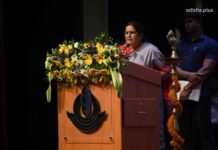Pradeep Kumar Panda
Odisha has made significant progress in reducing child under-nutrition less than India as a whole, but more than other states, such as Bihar, Uttar Pradesh, and Madhya Pradesh, according to government data studied by the International Food Policy Research Institute (IFPRI).

In Odisha, stunting, low height for age and a sign of malnutrition, reduced from 46.5% of children below five years in 2005-06 to 35.3% in 2015-16; the proportion of underweight children decreased from 42.3% of children below five years to 35.8%; and the Integrated Child Development Services (ICDS), the government’s child nutrition and education program, reached 34% more people in 2017 than it had in 2014.

As National Nutrition Week gets under way on September 1, 2019, and the Indian government prepares to launch PoshanAbhiyaan with an aim to improve nutrition among children, pregnant women and lactating mothers and make India malnutrition-free by 2022, we examine the success of Odisha.
IFPRI, a research advocacy based in Washington D.C., studied the progress of several countries and 28 Indian states, identifying Odisha as a “nutrition champion”, along with Thailand, Brazil, Bangladesh, Nepal, Peru, Vietnam and Ethiopia.
India’s ICDS programme is the world’s largest nutrition programme, launched in 1975 to address health, nutrition and pre-school education of children under the age of six years. The programme operates through a network of Anganwadi centres that provide services for pregnant and lactating women, and for children aged six months to six years. The programme mandates one Anganwadi per village or for a population of 1,000.

Odisha’s performance on delivering health and education services to children and mothers through this programme was among the best in India and got progressively better between 1992 and 2014, found a study, part of a book, ‘Nourishing millions: Stories of Change in Nutrition’, published by IFPRI.
Odisha has demonstrated significant commitment to reducing undernutrition, expanded nationally sponsored nutrition-specific programmes, and launched state-led initiatives relevant to improving nutrition. Odisha also decentralized service delivery through self-help groups and focused on equitable access to interventions for the entire population.
The study on India, India’s Integrated Child Development Services programme; equity and extent of coverage in 2006 and 2016, and part of the book, was co-authored by researchers at IFPRI and the University of Washington, US, using data from three rounds of the National Family Health Survey (NFHS) and the Rapid Survey on Children (RSOC).

Odisha’s rate of decline in childhood stunting low height for age is at least three times the rate of decline in other similarly poor states such as Bihar, the study found. The rate of stunting decline in Odisha has accelerated from 1.8 % a year to 2.1% a year in the past 10 years, the study found.
Odisha has performed better than richer states, such as Gujarat, and better than poor states such as Bihar, in delivering ICDS.
In Odisha, coverage of antenatal care went up from 48.3% of beneficiaries in 2005 to 64% in 2015, compared to Bihar where it increased from 16.9% in 2005-06 to 18.7% in 2014-15. In Maharashtra, this proportion increased from 62.1% to 67.6%.
Institutional births-births in a medical centre under the supervision of a medical professional-increased from 35.6% of all births to 85.3% in 10 years to 2015 in Odisha. In Bihar, this went up from 19.9% in 2005 to 63.8% in 2015.

The proportion of 12- to 23-month-old children immunised increased from 51.8% in 2005 to 78.6% in 2015 in Odisha. In Bihar, this increased from 32.8% in 2005 to 61.7% in 2015. In Maharashtra, this was 58.8% in 2005 and 56.2% in 2015.
Along with Odisha, Jammu and Kashmir, Meghalaya, Tripura and Bihar had the highest increase in the number of pre-school beneficiaries, according to a 2019 report by Accountability Initiative, a New Delhi-based think-tank.
In Odisha, 34 % more children were enrolled in pre-school education in Anganwadi centres in 2017 when compared with 2014, according to Accountability Initiative’s analysis. In comparison, in Rajasthan, children enrolled decreased by 12%, and by 15% in Maharashtra, in the same time period.

Overall, Odisha and West Bengal had the most ICDS beneficiaries out of the registered population of children up to six years of age. In Odisha, of all castes, scheduled castes and tribes–marginalised communities entitled to certain benefits under the Indian constitution–utilised ICDS services the most, according to the Accountability Initiative report.
All children registered in an Anganwadi centre should receive take-home rations and hot, cooked meals. The proportion of children who received these was 88% of registered children in Odisha, 83% in Gujarat, 39% in Haryana and 33% in Rajasthan as of March 2017, the report said.
Odisha performed more strongly in reducing undernutrition compared to richer states due to several factors. For instance, the expansion of coverage of nutrition-specific programmes has been strong.
Anganwadi centres are the first point of service delivery for health, nutrition and early learning for children at the village level. Of the 1.4 million sanctioned centres in India, 1.36 million (97%) were operational in September 2017, according to the report by Accountability Initiative. Odisha had one of the lowest proportions of non-functional anganwadis (3%), the report said.

Of 11 states studied, Odisha was one of the few states to hike the remuneration of anganwadi workers–honorary workers from the local community who provide government services to children, pregnant and nursing women–from October 2017, as reported by IndiaSpend on February 23 2018. Their pay increased from Rs 4,000 to Rs 6,000.
As many as 39% of sanctioned positions for child development project officers–the key functionary under ICDS–and 35% of sanctioned positions for ICDS supervisors were vacant across the country, as of March 2017, according to the Accountability Initiative analysis.
In Odisha, 2% of child development officer posts and 27% of supervisor posts were vacant, as compared to 76% and 23% in Maharashtra, respectively, and 69% and 39% in Rajasthan, data show.
Overall, Odisha has made faster progress in Child and Maternal Health than other Indian states.
(The author is a New Delhi based Economist)

























